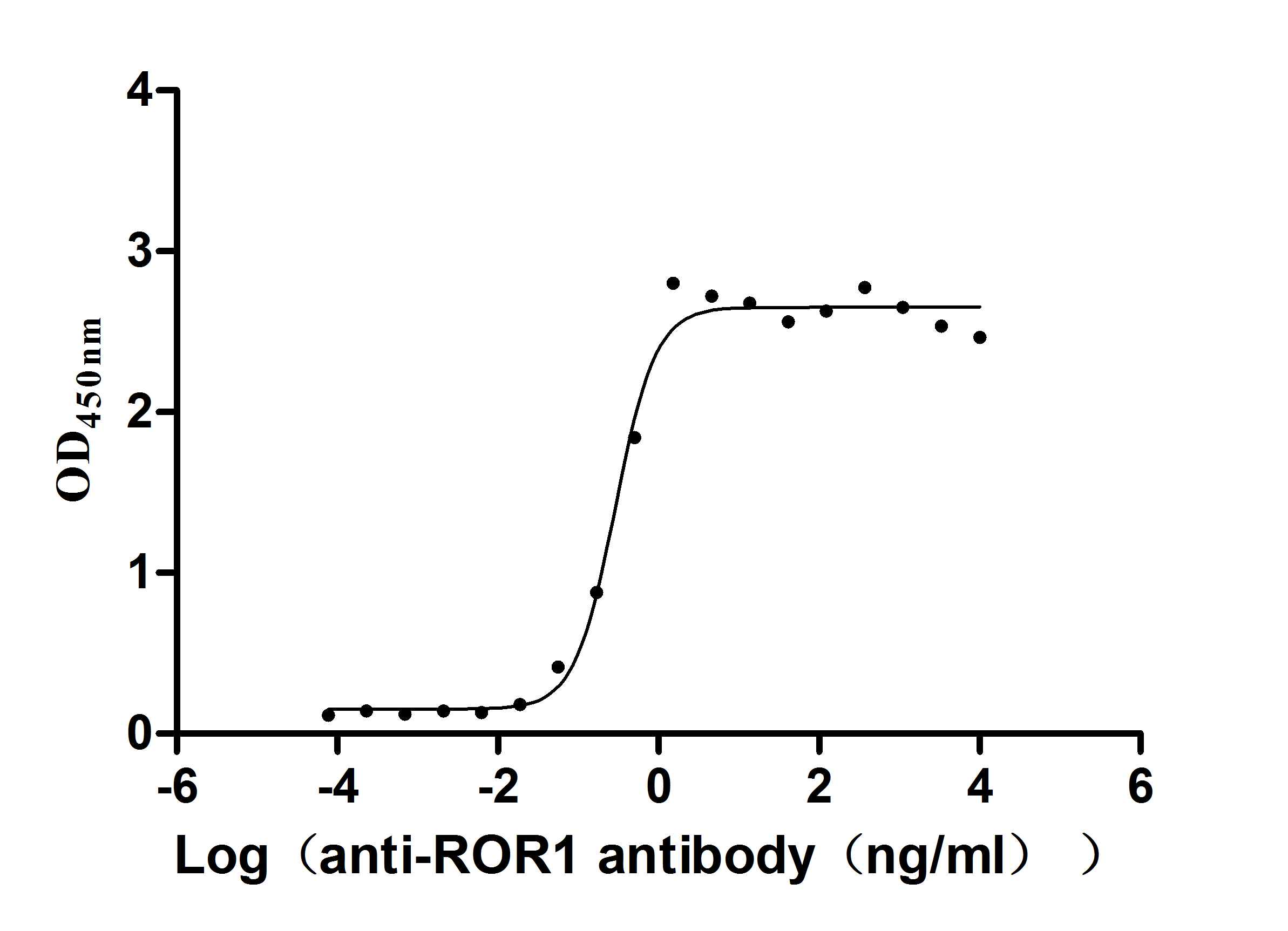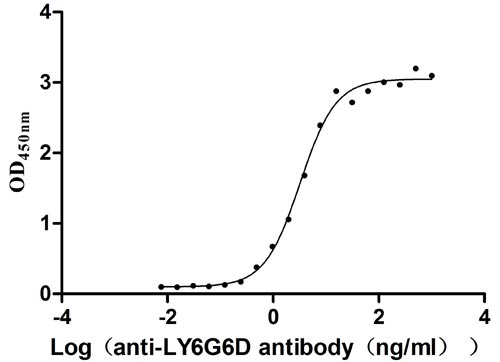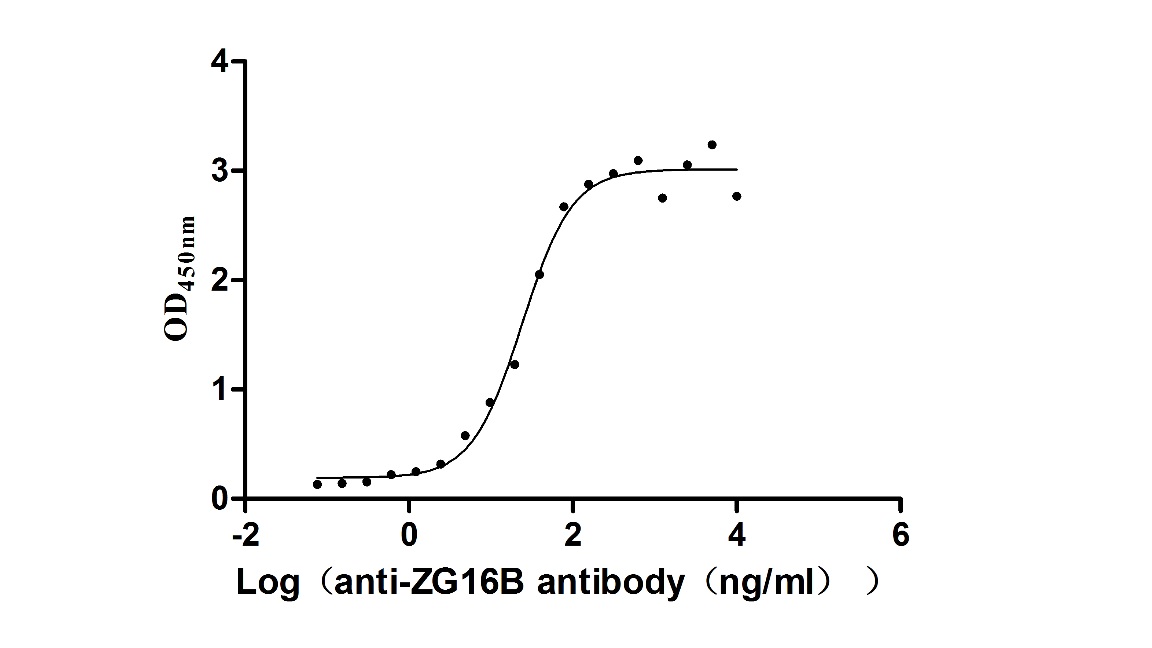Recombinant Rat Glutathione S-transferase P (Gstp1)
-
货号:CSB-YP009989RA
-
规格:
-
来源:Yeast
-
其他:
-
货号:CSB-EP009989RA-B
-
规格:
-
来源:E.coli
-
共轭:Avi-tag Biotinylated
E. coli biotin ligase (BirA) is highly specific in covalently attaching biotin to the 15 amino acid AviTag peptide. This recombinant protein was biotinylated in vivo by AviTag-BirA technology, which method is BriA catalyzes amide linkage between the biotin and the specific lysine of the AviTag.
-
其他:
-
货号:CSB-BP009989RA
-
规格:
-
来源:Baculovirus
-
其他:
-
货号:CSB-MP009989RA
-
规格:
-
来源:Mammalian cell
-
其他:
产品详情
-
纯度:>85% (SDS-PAGE)
-
基因名:
-
Uniprot No.:
-
别名:Gstp1; Glutathione S-transferase P; EC 2.5.1.18; Chain 7; GST 7-7; GST class-pi
-
种属:Rattus norvegicus (Rat)
-
蛋白长度:Full Length of Mature Protein
-
表达区域:2-210
-
氨基酸序列PPYTIVYFP VRGRCEATRM LLADQGQSWK EEVVTIDVWL QGSLKSTCLY GQLPKFEDGD LTLYQSNAIL RHLGRSLGLY GKDQKEAALV DMVNDGVEDL RCKYGTLIYT NYENGKDDYV KALPGHLKPF ETLLSQNQGG KAFIVGNQIS FADYNLLDLL LVHQVLAPGC LDNFPLLSAY VARLSARPKI KAFLSSPDHL NRPINGNGKQ
-
蛋白标签:Tag type will be determined during the manufacturing process.
The tag type will be determined during production process. If you have specified tag type, please tell us and we will develop the specified tag preferentially. -
产品提供形式:Lyophilized powder
Note: We will preferentially ship the format that we have in stock, however, if you have any special requirement for the format, please remark your requirement when placing the order, we will prepare according to your demand. -
复溶:We recommend that this vial be briefly centrifuged prior to opening to bring the contents to the bottom. Please reconstitute protein in deionized sterile water to a concentration of 0.1-1.0 mg/mL.We recommend to add 5-50% of glycerol (final concentration) and aliquot for long-term storage at -20℃/-80℃. Our default final concentration of glycerol is 50%. Customers could use it as reference.
-
储存条件:Store at -20°C/-80°C upon receipt, aliquoting is necessary for mutiple use. Avoid repeated freeze-thaw cycles.
-
保质期:The shelf life is related to many factors, storage state, buffer ingredients, storage temperature and the stability of the protein itself.
Generally, the shelf life of liquid form is 6 months at -20°C/-80°C. The shelf life of lyophilized form is 12 months at -20°C/-80°C. -
货期:Delivery time may differ from different purchasing way or location, please kindly consult your local distributors for specific delivery time.Note: All of our proteins are default shipped with normal blue ice packs, if you request to ship with dry ice, please communicate with us in advance and extra fees will be charged.
-
注意事项:Repeated freezing and thawing is not recommended. Store working aliquots at 4°C for up to one week.
-
Datasheet :Please contact us to get it.
相关产品
靶点详情
-
功能:Conjugation of reduced glutathione to a wide number of exogenous and endogenous hydrophobic electrophiles. Involved in the formation of glutathione conjugates of both prostaglandin A2 (PGA2) and prostaglandin J2 (PGJ2). Participates in the formation of novel hepoxilin regioisomers. Regulates negatively CDK5 activity via p25/p35 translocation to prevent neurodegeneration.
-
基因功能参考文献:
- The cytotoxic action of 2-acetylaminofluorene that give rise to the GST-P(+) single hepatocytes was suggested to be an injury to the excretory pump(s) and the duct of hepatocytes. A new physiological mechanism was hypothesized for the induction of preneoplastic cell populations in the rat liver instead of a genetic mechanism. PMID: 29501922
- Data suggest that expression of Gstp1 can be regulated by dietary factors; here, Gstp1 is induced in hepatocytes by carnosic acid, an anticarcinogenic component of rosemary (Rosmarinus officinalis). PMID: 25974399
- Data show that Valerian extract inhibits hepatocarcinogenesis by suppressing cell proliferation and inducing apoptosis in glutathione S-transferase pi GST-P(+) foci by activating gamma-aminobutyric acid A receptor GABA(A)RA1-mediated signaling. PMID: 25419570
- Cisplatin metabolism in different organs of rats correlated positively with specific GSTP1 activities and this enzyme may be a critical determinant of extent of cellular uptake or retention of cisplatin in renal and liver tissues. PMID: 24474500
- GSTP1 application early after myocardial infarction results in long-term beneficial structural and functional effects that prevent progression to heart faiilure. PMID: 24412522
- GST-P(-) foci induced by promotion with agonists of peroxisome proliferator-activated receptor-alpha. PMID: 20423715
- GSTpi directly associated with signal transducer and activator of transcription 3 (STAT3) to prevent Angiotensin II-triggered binding of Src to STAT3. PMID: 24321768
- The change in expression of GST-pi in peripheral blood showed the same pattern as that in brain tissues, suggesting GST-pi might contribute to drug resistance in epilepsy. PMID: 22038365
- GST-P-positive lesions may involve a mechanism facilitating lipid peroxidation PMID: 20091025
- Exposure to diesel exhaust particles elevated transcription of glutathione-s-transferase gene in rat alveolar macrophages. PMID: 12011483
- GSTpi proteins play an important role in the development of acquired drug resistance to various drugs of prostate cancer cells. PMID: 15809768
- glutathione S-transferase P1 is induced by proteasome inhibitors PMID: 15863507
- Hepaticcgene expression is upregulated by a limited availability of sulfur amino acids PMID: 15867277
- GST-Pi expression was induced by the metabolites of cyclophoshamide. PMID: 16242832
- Expression of GST-P gene is down-regulated by CCAAT enhancer-binding protein alpha in normal liver. PMID: 16407263
- Drug resistant prostate cancer cells displayed significantly increased expression of GSTP1 with other prostate cancer cells. PMID: 16728343
- The upregulation of MIF and GSTpi during the development of acquired drug resistance of hormone independent prostate cancer may modulate the activation of gp-170 PMID: 16728344
- Expression of GST-P is correlated with cellular proliferation and is associated with risk and progression of oral cancer. PMID: 17596925
- These data indicate that expression of GST-P may reflect the carcinogenic effect of cigarette smoke as well as the genetic susceptibility of animals in relation to continuous carcinogens exposure. PMID: 17786572
- development of GST-P-negative foci during the early stage of hepatocarcinogenesis PMID: 18081878
显示更多
收起更多
-
亚细胞定位:Cytoplasm. Mitochondrion. Nucleus.
-
蛋白家族:GST superfamily, Pi family
-
组织特异性:Present in kidney, lung, testis and placenta, very low levels in liver.
-
数据库链接:
KEGG: rno:24426
STRING: 10116.ENSRNOP00000024601
UniGene: Rn.87063
Most popular with customers
-
Express system: Mammalian cell
Species: Homo sapiens (Human)
-
Recombinant Mouse Claudin-18 (Cldn18)-VLPs (Active)
Express system: Mammalian cell
Species: Mus musculus (Mouse)
-
Recombinant Human Microtubule-associated protein tau (MAPT) (Active)
Express system: Mammalian cell
Species: Homo sapiens (Human)
-
Recombinant Human Interleukin-17A (IL17A) (T26A) (Active)
Express system: Baculovirus
Species: Homo sapiens (Human)
-
Recombinant Human Lymphocyte antigen 6 complex locus protein G6d (LY6G6D) (Active)
Express system: Yeast
Species: Homo sapiens (Human)
-
Recombinant Human Desmoglein-3 (DSG3), partial (Active)
Express system: Baculovirus
Species: Homo sapiens (Human)
-
Recombinant Human Tumor-associated calcium signal transducer 2 (TACSTD2), partial (Active)
Express system: Mammalian cell
Species: Homo sapiens (Human)
-
Recombinant Macaca fascicularis zymogen granule protein 16 homolog B (ZG16B) (Active)
Express system: Mammalian cell
Species: Macaca fascicularis (Crab-eating macaque) (Cynomolgus monkey)



-AC1.jpg)
-AC1.jpg)
-AC1.jpg)














